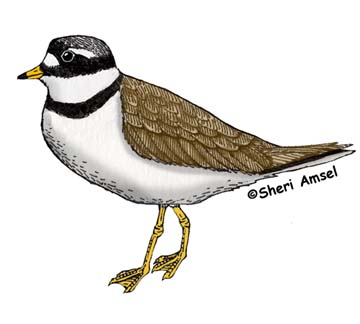

They winter on the west coast from Northern California to South America and on the east coast from Virginia to South America. In the summer, they travel to Alaska across Canada and to Newfoundland to breed.
They are found on beaches and mudflats.
They are small with a short neck and long yellowish-orange legs. They have a dark back and light underparts. Dark stripes on the face and chest make the white band around the neck stand out as a good identification trait. They have a yellowish-orange beak with a black tip.
They run a few steps, stop, look and then run a few more steps. Then when they see prey, they stop, peck and grab and move on.
They eat insects, crayfish, snails, and other small creatures (invertebrates) found along and in the water.
Kingdom: Animalia
Phylum: Chordata
Subphylum: Vertebrata
Class: Aves
Order: Charadriiformes
Family: Charadriidae
Genus: Charadrius
Species: C. semipalmatus
When you research information you must cite the reference. Citing for websites is different from citing from books, magazines and periodicals. The style of citing shown here is from the MLA Style Citations (Modern Language Association).
When citing a WEBSITE the general format is as follows.
Author Last Name, First Name(s). "Title: Subtitle of Part of Web Page, if appropriate." Title: Subtitle: Section of Page if appropriate. Sponsoring/Publishing Agency, If Given. Additional significant descriptive information. Date of Electronic Publication or other Date, such as Last Updated. Day Month Year of access < URL >.
Amsel, Sheri. "Plover (Semipalmated)" Exploring Nature Educational Resource ©2005-2024. December 13, 2024
< http://mail.exploringnature.org/db/view/223 >

